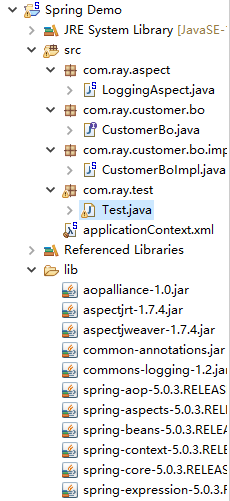在这个Spring AOP+ AspectJ 示例中,让您轻松实现拦截方法。
常见AspectJ的注解:
- @Before – 方法执行前运行。
- @After – 运行在方法返回结果后。
- @AfterReturning – 运行在方法返回一个结果后,在拦截器返回结果。
- @AfterThrowing – 运行方法在抛出异常后。
- @Around – 围绕方法执行运行,结合以上这三个通知。
String AOP所需的jar包
1. 目录结构
看到这个例子的目录结构。
2. Spring Beans
普通 bean 中有几个方法,后来通过 AspectJ 注解拦截。
File:CustomerBo.java
public interface CustomerBo {
void addCustomer();
String addCustomerReturnValue();
void addCustomerThrowException() throws Exception;
void addCustomerAround(String name);
}
File:CustomerBoImpl.java
public class CustomerBoImpl implements CustomerBo{
@Override
public void addCustomer() {
System.out.println("addCustomer() is running");
}
@Override
public String addCustomerReturnValue() {
System.out.println("addCustomerReturnValue() is running");
return "abc";
}
@Override
public void addCustomerThrowException() throws Exception {
System.out.println("addCustomerThrowException() is running");
throw new Exception("Error");
}
@Override
public void addCustomerAround(String name) {
System.out.println("addCustomerAround() is running, args: " + name);
}
}3. 启用AspectJ
在 Spring 配置文件,把“<aop:aspectj-autoproxy />”,并定义Aspect(拦截)和普通的bean。
File:applicationContext.xml
<?xml version="1.0" encoding="UTF-8"?>
<beans xmlns="http://www.springframework.org/schema/beans"
xmlns:xsi="http://www.w3.org/2001/XMLSchema-instance"
xmlns:aop="http://www.springframework.org/schema/aop"
xsi:schemaLocation="http://www.springframework.org/schema/beans
http://www.springframework.org/schema/beans/spring-beans.xsd
http://www.springframework.org/schema/aop
http://www.springframework.org/schema/aop/spring-aop.xsd">
<aop:aspectj-autoproxy/>
<bean id="customerBo" class="com.ray.customer.bo.impl.CustomerBoImpl"/>
<!-- Aspect -->
<bean id="logAspect" class="com.ray.aspect.LoggingAspect"/>
</beans>4. AspectJ @Before
在下面例子中,logBefore()方法将在 customerBo接口的 addCustomer()方法的执行之前被执行。
AspectJ的“切入点”是用来声明哪种方法将被拦截,应该参考
Spring AOP切入点指南,支持切入点表达式的完整列表。
File : LoggingAspect.java
@Aspect
public class LoggingAspect {
@Before("execution(* com.ray.customer.bo.CustomerBo.addCustomer(..))")
public void logBefore(JoinPoint joinPoint) {
System.out.println("logBefore() is running!");
System.out.println("getName(): " + joinPoint.getSignature().getName());
System.out.println("******");
}
}执行程序
public class Test {
public static void main(String[] args) {
ApplicationContext context = new ClassPathXmlApplicationContext("applicationContext.xml");
CustomerBo customer = (CustomerBo) context.getBean("customerBo");
customer.addCustomer();
}
}执行结果
logBefore() is running!
getName(): addCustomer
******
addCustomer() is running5. AspectJ @After
在下面例子中,logAfter()方法将在 customerBo 接口的 addCustomer()方法的执行之后执行。
File : LoggingAspect.java
@Aspect
public class LoggingAspect {
@After("execution(* com.ray.customer.bo.CustomerBo.addCustomer(..))")
public void logAfter(JoinPoint joinPoint) {
System.out.println("logAfter() is running!");
System.out.println("getName(): " + joinPoint.getSignature().getName());
System.out.println("******");
}
}
addCustomer() is running
logBefore() is running!
getName(): addCustomer
******6. AspectJ @AfterReturning
在下面例子中,logAfterReturning()方法将在 customerBo 接口的addCustomerReturnValue()方法执行之后执行。此外,还可以截取返回的值使用“returning”属性。
要截取返回的值,对“returning”属性(结果)的值必须用相同的方法参数(结果)。
File : LoggingAspect.java
@Aspect
public class LoggingAspect {
@AfterReturning(
pointcut = "execution(* com.ray.customer.bo.CustomerBo.addCustomerReturnValue(..))",
returning = "result")
public void logAfterReturning(JoinPoint joinPoint,Object result) {
System.out.println("logAfterReturning() is running!");
System.out.println("getName(): " + joinPoint.getSignature().getName());
System.out.println("Method returned value is : " + result);
System.out.println("******");
}
}执行程序
public class Test {
public static void main(String[] args) {
ApplicationContext context = new ClassPathXmlApplicationContext("applicationContext.xml");
CustomerBo customer = (CustomerBo) context.getBean("customerBo");
customer.addCustomerReturnValue();
}
}执行结果
addCustomerReturnValue() is running
logAfterReturning() is running!
getName(): addCustomerReturnValue
Method returned value is : abc
******7. AspectJ @AfterThrowing
在下面的例子中,如果 customerBo 接口的addCustomerThrowException()方法抛出异常logAfterThrowing()方法将被执行。
File : LoggingAspect.java
@Aspect
public class LoggingAspect {
@AfterThrowing(
pointcut = "execution(* com.ray.customer.bo.CustomerBo.addCustomerThrowException(..))",
throwing = "error")
public void logAfterThrowing(JoinPoint joinPoint,Throwable error) {
System.out.println("logAfterThrowing() is running!");
System.out.println("getName(): " + joinPoint.getSignature().getName());
System.out.println("Exception : " + error);
System.out.println("******");
}
}
public class Test {
public static void main(String[] args) throws Exception {
ApplicationContext context = new ClassPathXmlApplicationContext("applicationContext.xml");
CustomerBo customer = (CustomerBo) context.getBean("customerBo");
customer.addCustomerThrowException();
}
}addCustomerThrowException() is running
logAfterThrowing() is running!
getName(): addCustomerThrowException
Exception : java.lang.Exception: Error
******
Exception in thread "main" java.lang.Exception: Error
at com.ray.customer.bo.impl.CustomerBoImpl.addCustomerThrowException(CustomerBoImpl.java:21)8. AspectJ @Around
在下面例子中,logAround()方法将在customerBo接口的addCustomerAround()方法执行之前执行, 必须定义“proceed();” 控制何时拦截器返回控制到原来的addCustomerAround()方法。
File : LoggingAspect.java
@Aspect
public class LoggingAspect {
@Around("execution(* com.ray.customer.bo.CustomerBo.addCustomerAround(..))")
public void logAround(ProceedingJoinPoint pjp) throws Throwable {
System.out.println("logAround() is running!");
System.out.println("getName(): " + pjp.getSignature().getName());
System.out.println("getArgs(): " + Arrays.toString(pjp.getArgs()));
System.out.println("Around before is running!");
pjp.proceed(); //continue on the intercepted method
System.out.println("Around after is running!");
System.out.println("******");
}
}执行程序
public class Test {
public static void main(String[] args) throws Exception {
ApplicationContext context = new ClassPathXmlApplicationContext("applicationContext.xml");
CustomerBo customer = (CustomerBo) context.getBean("customerBo");
customer.addCustomerAround("Ray");
}
}
执行结果:
logAround() is running!
getName(): addCustomerAround
getArgs(): [Ray]
Around before is running!
addCustomerAround() is running, args: Ray
Around after is running!
******总结
它总是建议采用最少 AspectJ 注解。这是关于Spring AspectJ 的一篇相当长的文章。。























 366
366

 被折叠的 条评论
为什么被折叠?
被折叠的 条评论
为什么被折叠?








